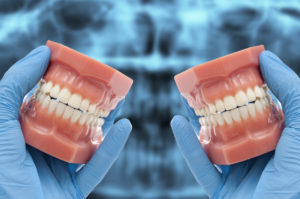
Do you find yourself wondering if you need to correct your bite pattern? A misaligned bite, also known as malocclusion, can affect your body and oral health. Knowing when it’s time to correct them is essential for maintaining your oral health. In this blog, we look at the causes of misalignment and explore the different types of bite patterns. We also discuss when it is necessary to correct a person’s bite. By correcting a misaligned bite, you can make informed decisions about your teeth.
Why Does a Bite Pattern Become Misaligned?
Several factors contribute to the misalignment of bite patterns. Having crooked or crowded teeth is the most common cause of misaligned bite patterns. When you have misaligned or crowded teeth, it can lead to a misaligned bite pattern. This can occur due to genetic factors, thumb sucking, or long-term pacifier use. If there is a misalignment between the dental arches, this can also affect your bite pattern. The upper and lower dental arches should align and be uniform. If there is a discrepancy in their alignment, it can result in a misaligned bite. In some cases, trauma or injury to the jaw or teeth can cause a shift in the bite pattern. Accidents or impacts to the face can disrupt the proper alignment of the teeth and jaws.
Types of Bite Patterns
There are several types of bite patterns that can occur due to misalignment.
- Overbite. An overbite occurs when the upper teeth overlap the lower teeth. This may result in the lower teeth impacting the roof of the mouth. This can lead to potential dental issues and decreased functionality.
- Underbite. An underbite happens when the lower teeth protrude further than the upper teeth. This misalignment can cause difficulties with chewing, speaking, and dental health.
- Crossbite. A crossbite refers to a lateral misalignment of the dental arches. It occurs when some of the upper teeth interact with the lower teeth when biting down. This can lead to tooth wear, jaw pain, and difficulty with proper dental hygiene.
When Is It Indicated to Correct a Bite Pattern?
Not all cases of misaligned bite patterns will need correction. But certain situations may need treatment. If the misalignment affects your ability to eat or talk, you should correct the alignment. Aligned teeth enable efficient chewing and clear speech. Misaligned bites can also contribute to dental problems. These could include tooth decay, gum disease, jaw pain, and headaches. Correcting the bite can help fix these issues and improve oral health. Some people may be self-conscious about their smile due to a visible misalignment. Correcting the bite pattern can enhance their appearance and boost self-confidence.
Treatment Options for Misaligned Bite Patterns
Treating a misaligned bite pattern depends on the severity and type of misalignment. Orthodontic options like braces, clear aligners, or retainers can correct bite patterns. In more severe cases, orthognathic surgery may be necessary. It repositions the jaws and achieves proper alignment.
Contact Us
Correcting a misaligned bite pattern is essential for maintaining optimal oral health. By knowing when it’s time to correct your bite, you can make informed decisions about your oral health. Be mindful of the effects of misaligned bites. Consider treatment options to improve your oral well-being. If you need help with your bite pattern, contact Magnolia Dental. We can determine the best course of action for correcting your specific bite pattern. Let us work together to achieve a healthier smile.

